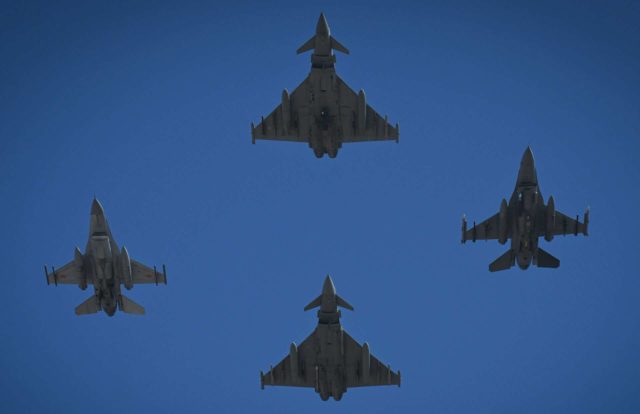
New requests bring military’s ‘unfunded priorities’ above $21 billion A Typhoon jet of the Royal Air Force (Up), a Typhoon jet of the Italian army (Bottom), an F-16 jet of the Romanian army (L) and a F-16 jet of the US Air Force fly in formation. (DANIEL MIHAILESCU/AFP via Getty Images/TNS)
Pentagon brass have asked Congress for nearly $1 billion for anti-missile and cybersecurity programs that are not part of President Joe Biden’s budget request, bringing to more than $21 billion the so-called unfunded priorities the armed services and military commands are seeking for fiscal 2023.
The Missile Defense Agency’s $748 million request to Congress and U.S. Cyber Command’s $236 million request, expressed in a pair of documents obtained by CQ Roll Call, are the latest of a bevy of unfunded lists provided to Congress in recent weeks.
The lists have become a de facto addendum to each president’s annual budget. They provide a way for lawmakers to know which military priorities could benefit from extra funds, and they bolster hawks’ arguments that defense spending is not meeting all the military’s needs.
While the documents are commonly known as “wish lists,” Sen. James M. Inhofe, R-Okla., a leading hawk, prefers to call them “risk lists.”
The disagreement over terminology illustrates the divergent ways the requests are viewed. Some critics see them as institutionalizing excess in defense spending.
Both schools of thought may be partly right. Regardless, Congress often meets the bulk of these additional funding requests.
This year will probably be no different. Byron Callan, an analyst with Capital Alpha Partners, a Washington-based consulting firm that conducts research on the defense budget, wrote in a note to investors this month that the billions of dollars on the unfunded lists are just a “starting point” for what Congress is likely to add to the defense budget for fiscal 2023.
More money will probably be added on top of the unfunded billions on the lists so that the defense budget can account for the amount by which inflation is expected to exceed the administration’s projections for fiscal 2023, Callan noted. The administration built the defense budget on an assumption of 4 percent inflation in defense, a measure that differs from the consumer price index. But defense inflation could be higher in fiscal 2023, though no one knows by how much.
Hypersonic focus
The Missile Defense Agency’s fiscal 2023 unfunded priorities request totals $748 million, and nearly half of it — or about $318 million — would be dedicated to programs aimed at combating the hypersonic missiles China and Russia are fielding.
Hypersonic missiles have the velocity of ballistic missiles but are more maneuverable and so pose greater challenges for anti-missile systems.
Included in that $318 million is $25 million for “disruptive” future technology to combat hypersonics.
The agency also wants more money to fund a number of other futuristic technologies. These include $22 million for a high-energy laser that could shoot down hypersonic and other airborne threats and $29 million for a high-energy microwave anti-missile system.
At least $121 million of the request is for classified programs. And $30 million is for ensuring the cybersecurity of U.S. missile defense systems.
‘Strategic competitor targets’
Meanwhile, U.S. Cyber Command has asked Congress for $236 million that was not in its budget request for fiscal 2023. The command describes the objectives of these projects only broadly.
About half of this request — or $168 million — is to fund operations of the cyber mission force, including training and curriculum development.
Some $56 million would go to improving the readiness of the people and computers involved in taking on cyber threats.
And $12 million would go toward improving intelligence capabilities “to gain access to strategic competitor targets,” almost certainly a reference to China and possibly Russia.
$21.4 billion more
Biden’s fiscal 2023 national defense budget request is $813 billion, $773 billion of which is for the Defense Department.
All told, Defense Department offices have sought some $21.4 billion for programs that did not make the president’s budget — or nearly 3 percent of the $773 billion Pentagon total.
The armed services’ fiscal 2023 unfunded lists were somewhat evenly divided this year: $5.1 billion for the Army, $4.6 billion for the Air Force and $639 million for the Space Force, $4 billion for the Navy, and $3.5 billion for the Marine Corps.
The military’s regional and functional commands also submit requests. The most expensive of these was the $1.5 billion sought by U.S. Indo-Pacific Command.
___
© 2022 CQ-Roll Call, Inc Distributed by Tribune Content Agency, LLC




